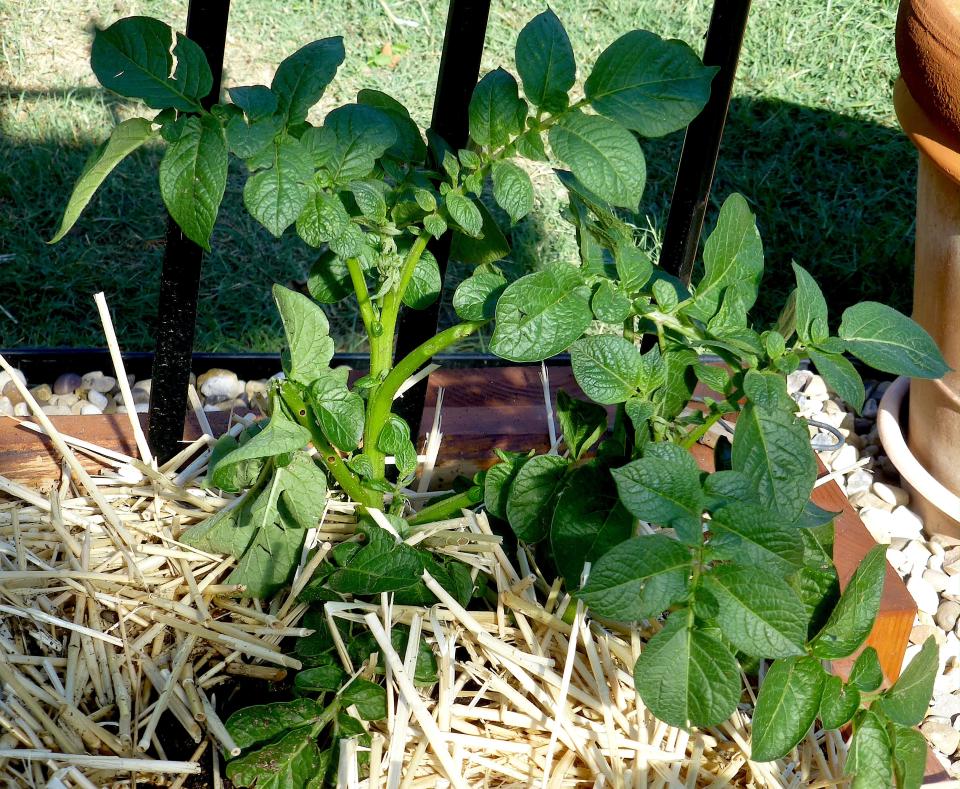Gardening for You: Hilling potatoes for better tubers
Those white potatoes that were planted on the Ides of March have a lot of activity going on under the ground right now. While the above ground green shoots put out new leaves and stems the underground tubers form and swell.

Edible portions of white potatoes are the tubers, specialized underground storage organs developed from stem tissues. Tubers form below and laterally from the main stem. The scientific name of the white potato, Solanum tuberosum, identifies its growth habit: the genus Solanum, as it is a member of the Solanaceae family, and the species tuberosum for the production of tubers. Interestingly, and even humorously, the term tuber comes from the Latin meaning lump or bump.
All green parts of potatoes - leaves, stems, seeds, and fruit are poisonous due to high levels of glycoalkaloids. Glycoalkaloids are alkaloids to which a sugar (glucose) is attached and which serve as a defense mechanism against insects and pathogens in vegetables.
The main glycoalkaloid in the white potato is solanine (SOL-a-neen), a naturally produced neurotoxin present in green potatoes. Solanine is the bitter alkaloid that concentrates in the peel, is not broken down by cooking, and when consumed in high levels solanine can be toxic to humans.
Solanine is important to gardeners since potato tubers exposed to light will accumulate this alkaloid. Thus, the importance of hilling potatoes as they grow.
Hilling or hilling up is the cultural term used in potato production where loose organic matter and soil is mounded to cover potato shoots as the tops grow. The practice of hilling tomatoes serves two purposes:
Hilling potatoes with organic matter provides material needed for deeper and wider tuber formation since tubers develop horizontally from the main stem. With sufficient material to expand new tubers continue to be produced above earlier-formed tubers. Straw mixed with soil is a good source of organic matter.
The second purpose of hilling potatoes has to do with solanine production. Tubers grown near the soil surface perceive light, initiating a cascade of events: the alkaloid solanine is synthesized, leading to accumulation of the alkaloid, greening of the tuber and production of the bitter toxin. The higher the sunlight, the greater the greening.

Hilling potatoes can actually be an enjoyable gardening activity. The shoots of the potato grow quickly sometimes several inches in a day. Begin hilling when stems are about six inches in height. Pile organic matter or soil loosely around potato stems, leaving a few leaves uncovered. New tubers form under the mounded soil. As stems continue to grow, continue hilling up by adding fresh soil mixed with organic matter.
Continue hilling until plants mature. Spring potatoes planted in March will be ready for harvest in about 80 days when flowers appear. At this point a decision needs to be made. For baby potatoes (new potatoes) tubers can be harvested two or so weeks after flowering but for larger, mature tubers wait for foliage to die back.
Ellen Peffley taught horticulture at the college level for 28 years, 25 of those at Texas Tech, during which time she developed two onion varieties. She is now the sole proprietor of From the Garden, a market garden farmette. You can email her at gardens@suddenlink.net
This article originally appeared on Lubbock Avalanche-Journal: Gardening for You: Hilling potatoes for better tubers

